Introduction
AI assistants like ChatGPT, Gemini, Perplexity, and Grok are transforming how users discover brands—but unlike search engines, these tools don’t rely on crawling hundreds of pages. They prioritize clarity, structure, and semantic hierarchy. This article explains how to structure your website to ensure it’s not only discoverable by traditional search engines but also legible and valuable to AI models seeking to summarize, cite, and recommend your content.
Why Website Structure Matters for AI Discoverability
AI models interpret web content based on:
- Structured metadata (schema.org)
- Clear hierarchical formatting (headings, breadcrumbs)
- Semantic consistency (brand identity, topical clarity)
A disorganized or overly complex site may confuse AI parsing logic, causing your brand to be ignored or misrepresented in answers.
Core Principles of AI-Optimized Site Architecture
- Minimalism: Reduce content depth to 2–3 clicks max
- Semantic clarity: H1-H6 usage, plain language subheads
- Structured metadata: Implement robust schema across key pages
- Prompt alignment: Organize content around question-answer logic
Entity consistency: Reinforce brand identity in copy, titles, and metadata
Key Elements to Include for Better AI Parsing
4.1 Clear Navigation and URL Taxonomy
- Use clean, readable URLs (e.g., /about, /solutions/ai-seo)
- Avoid query strings and ambiguous slugs (e.g., /index.php?id=54)
Organize navigation around user intent: About, Solutions, Blog, FAQ
4.2 Consistent Entity Markup Across Pages
- Define your brand in a consistent way across all pages
Use Organization schema on homepage, Product schema on tool pages, and WebPage schema globally
4.3 Schema Types That Improve AI Understanding
- FAQPage for support content
- AboutPage for entity grounding
- BreadcrumbList for context in multi-page journeys
SoftwareApplication or Product for SaaS tools
4.4 Content Blocks That Mirror Common Prompts
- Include sections titled:
- “What is [Your Brand]?”
- “How does [Your Product] work?”
- “Why choose us?”
Use declarative, concise language that matches natural prompt phrasing
4.5 About and FAQ Pages as AI Anchors
- Your About page is often the primary summary reference in AI models
- FAQ pages signal trust, clarity, and source authority
- Use internal links from these to product and contact pages
Homepage: Designing for AI Indexing
- Feature a short, clear summary of what your brand does
- Include Organization schema with logo, contact, and sameAs links
- Link to your About, Product, and Blog pages in the top nav
Use headings like “What is RankPrompt?” or “Built for AEO” to establish topic
Internal Linking Strategy for Entity Visibility
- Use contextual internal links from blog posts to your explainer and product pages
- Link brand name to About page early and often
- Reinforce core terms like “AI SEO,” “AEO,” and “[Your Brand] visibility tool” across pages
Common Mistakes That Hurt AI Visibility
- No schema markup or incorrect implementation
- Multiple homepages or duplicate About pages
- Fluff content that doesn’t answer real questions
- Inconsistent brand naming conventions across meta and copy
- Thin or generic landing pages with no semantic clarity
Sample Site Structure for AI SEO
/about
/solutions/ai-seo
/solutions/prompt-tracking
/blog
/what-is-aeo
/how-to-rank-in-chatgpt
/faq
/contact
- All URLs structured for clarity
- Subfolders reinforce topic clustering
- Blog content links back to core product and About pages
Final Thoughts: Build for Bots and Humans
A well-structured site is the foundation for both SEO and AEO success. If your content is hard for a human to navigate, it’s nearly impossible for AI models to interpret, summarize, and recommend. Building for AI visibility means designing for precision, consistency, and semantic clarity.
Audit and Improve with RankPrompt
Not sure if your site is structured for AI discovery? Run a free audit at RankPrompt.com to scan your brand visibility across ChatGPT, Gemini, Perplexity, and Grok—and receive optimization tips tailored to your site’s current architecture.

